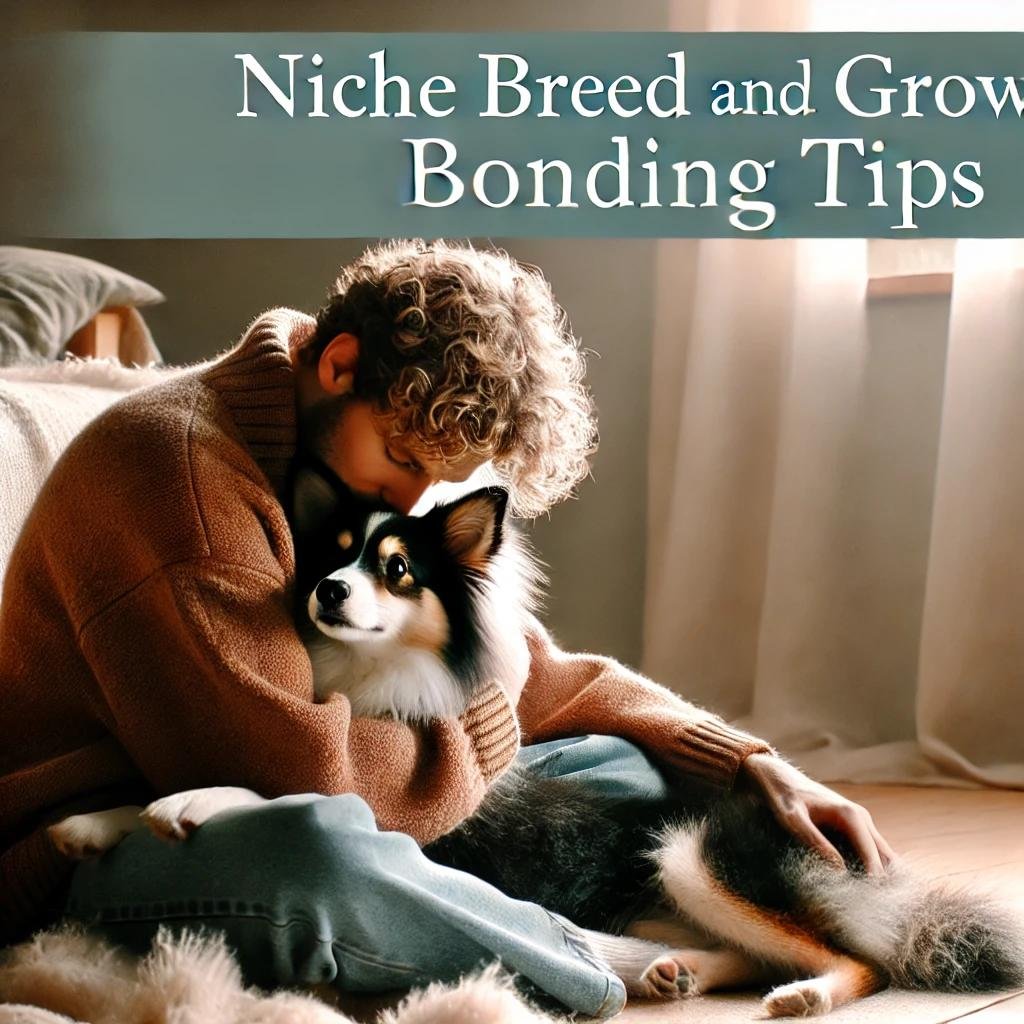Introduction: It is vital to have a close relationship with your pets, particularly when they belong to hard-to-find breeds. I sense that one either grows up with such breeds or comes to them as an adult. When I was young, my family was covetous of a purebred dog. My father seemed particularly intent on that notion. I still remember the warm, fuzzy feeling I got watching him comb through the fur of a massive Alaskan Malamute to check for breeding quality. I’m certain that Malamute didn’t appreciate it, but that’s the thing with niche breeds. To live with one is to know and understand it. To know is to understand its shared history with humans. That makes bonding with one something like entering into a compact with an unusual breed of dog.Niche breed and grow bonding tips for pet owners refer to strategies aimed at improving the pet-owner relationship
What are Niche Breed and Grow Bonding Tips?
Niche breed and grow bonding tips for pet owners refer to strategies aimed at improving the pet-owner relationship. These tips are tailored to the specific breeds that pet owners may have. As part of this series, we will offer specialized bonding techniques for unique, small canine breeds such as the Papillon, the Chihuahua, and the Min Pin. Engaging with your pet through these tips speaks to the overall health of your relationship. “The more we can commune with our pets, the more we bond in a special way that only humans and animals can.”
Understanding the Importance of Bonding in Niche Breeds
Forming a bond with your pet is crucial, especially with those of rare breeds. These animals sometimes have singular temperaments and tend to behave in ways that are not always predictable. It is most important to create a relationship with them based on trust and security, as it is this framework that is essential to their emotional health. Once you have established a bond, the work of training them becomes a lot more fruitful, as they are more responsive to a person they perceive as a “safe harbor.” In effect, bonding enhances the quality of life for both you and your pet, reducing the pet’s anxiety and also yours, and surely it must be said that the relationship between the two of you is the most important aspect of both your lives.
Top Tips for Successfully Bonding with Your Niche Breed
To bond successfully with a niche breed, patience and understanding are essential. Begin the bonding process by spending quality time with the pet. After the initial introduction, let the pet get used to your presence. This takes some time and is best accomplished with several calm and quiet “sessions” with the pet where you are just together. Regular interaction is a must for building trust, although I would caution not to take interaction for granted. Voice tones count. The voice used when addressing a pet can “make or break” its day. Using a gentle voice while giving commands and/or even just talking can set a positive tone for the interaction. “Good pets are the best lives.” This is something I firmly believe in and something I have been on the receiving end of too many times to count.
How to Choose the Right Niche Breed for Bonding?
For successful bonding, it is vital to choose the right niche breed. To do this, consider your lifestyle, your living space, and your availability for interaction with the animal. Some breeds may need more attention and care than others. Research the specific needs, temperaments, and possible health issues of the breeds you are interested in.
Creating a Comfortable Environment for Your Niche Breed
Your understanding of these factors will help you select a breed that fits your lifestyle and is more likely to bond with you. If you are comfortable with and can commit to space and time bonding, you might focus on a niche breed that is a low-shedding “hypoallergenic” dog and that has a temperament suitable for being a service animal.
It is very important to create an atmosphere of comfort for your niche breed. If there is one thing that “my niche” has learned from being relegated to the sidelines of dogdom, it is that we don’t really need a lot as long as the space we occupy meets our specific (and not very demanding) requirements. My kind likes it quiet, free from distractions, safe (and we can’t stress too much the importance of being secure in our surroundings), clean, and with enough cozy (but not too cozy) spaces to lie around and take a snooze when the occasion calls for it. That is pretty much the comfort outline that would apply to my kids, and surviving this routine has allowed us to gain a kind of mutual trust that is getting stronger all the time.
Bonding Activities: Fun Ways to Connect with Your Niche Breed and Grow Bonding Tips
Building activities is a fun way to reinforce your relationship with your niche breed. You can start with interactive games that engage their physical presence and mental capabilities. They will love fetch, but including something like gustatory hide-and-seek will put them on a whole different level of excitement. If you haven’t already, also consider puzzle toys. They not only keep the dogs occupied and out of trouble when you need to do something else, but they are also great for cognitive stimulation. Hiking with your dog (age permitting; you don’t want to risk joint issues for young and old dogs) is a great way to see your dog in a different light. You can increase or decrease the challenge level of the trail depending on how much fun you want to have together. Whether you’re hiking or at a dog park, you can challenge your dog to come across new experiences.
Common Challenges in Bonding with Niche Breeds And Grow Bonding Tips
Building a bond with a niche breed can present some unique hurdles to overcome. Some pets may be shy, and others have specific behavioral quirks that can make it hard to connect. But you do need to recognize and accept these challenges before you can work on overcoming them. For example, if your niche breed is fearful, patience and the “take it slow” approach are key. You should gradually introduce them to new environments and people. Make sure that you don’t interact with them too much so that they don’t become overwhelmed. Instead, have some small, positive interactions. If your pet’s behavior is more on the aggressive side of the scale, that’s definitely a sign that you need some help from a professional trainer.
Establishing a close relationship with your niche breed can be significantly aided by good nutrition. A sound, species-appropriate diet in which the animal’s salient nutritional requirements are met is highly conducive to the kind of bonding that makes for a happy “niche pet.”
The Role of Nutrition in Bonding with Your Niche Breed and Grow Bonding Tips
Incorporating Anabaptist treats into the bonding activities you engage in with your breed can help engender a more positive association. You might consider getting the help of your veterinarian in formulating your diets, especially if your pet is of a rare breed. A diet that meets each pet’s special requirements implies not only good nutrition but also better bonding, making for a happier, healthier “niche pet.”
Building Trust: Essential Tips for Bonding with Your Niche Breed
Creating a bond with your niche breed is all about establishing trust. While some interaction with your dog is necessary to build the bond you wish to create, what should establish the trust between you and your pet is a routine. This routine should center around their basic needs. “In the morning, I’m going to feed you. In the evening, I’m going to feed you. Throughout the day, I’m going to give you stuff to chew on, to play with, and to work your mind. I’m going to brush you and clean your ears. And then I’m going to leave you alone because this is your space.” At least twice a day, let your dog see your face and hear your voice and know that you are nearby. Use “uh-huh” and “good boy!” as you see fit. In your dog’s terms, this is Yo-Yo Ma playing Bach’s Cello Suites.
Niche Breeds: Understanding Their Unique Needs for Bonding
To bond effectively, it’s vital to understand that niche breeds have unique and specific needs. Each breed comes with its own built-in personality profile. If you don’t consider this, you’re basically flying blind. Just because two animals look somewhat alike doesn’t mean they’re the same. There’s ample evidence to suggest that even within a breed, bonded pairs tend to be quite different in how they relate to and with each other and to their human companions. That said, some traits are consistent within certain breeds and even across closely related ones. Getting to know the specific personality profile and typical bonding process of the breed you’re working with helps you avoid misunderstandings, saves you time on trial and error, and sets you on the right path to bonding.
How to Read Your Niche Breed’s Body Language?
In order to effectively bond with your niche breed, you must first understand its form of nonverbal communication. Although your breed may vary somewhat from the standard dog or cat, most pets display a relatively uniform set of signals. Relaxed body language means a relaxed pet. Recognizing the difference takes practice and a keen eye, but it’s the first step in adjusting headspace with your niche pet. High-stress situations can make even the most colocated pets act funny; understanding their ‘normal’ can help you interpret signs more accurately.
Tips for Maintaining a Strong Bond Over Time
It takes work to maintain a strong relationship with a niche breed, but the effort you put in will yield great rewards. The most important thing is to be consistent—whatever bonding activities your pet enjoys, do them regularly. Schedule playtime (or quiet, cozy “cuddle” time) for reinforcement. Keep their living space intriguing by introducing new toys or activities—they love novelty, especially with their toys. And if you’re not planning to train them seriously, you can still do “refreshers” on “commands” they already know. These sessions reinforce your bond, and they really do promote teamwork and trust—at least in the human half of the team! Always “ude” patience, and don’t forget to listen, because pets thrive on understanding; and “in my experience,” on the human side, this makes one feel secure, too.
Strengthening the Bond with Your Niche Breed
Building a relationship with your niche breed demands commitment and innovation. A bond is strengthened when new activities and experiences are shared. You can certainly go the easy route and do what your dog is comfortable with (same old, same old). But why not explore something different? In this month’s essay, we’re focusing on the ways you can deepen your relationship with your dog through learning and doing together, compounded by the outdoor adventures you might take, or have taken, as a pair. We frequently talk about the significance of keeping your dog mentally stimulated, but what about your own brain? You can also pursue with your dog some pretty cool, transformative experiences that will ensure he’s comfortable in your life and capable of doing life with you.
Conclusion
To sum up, establishing a bond with a specific breed of dog is most certainly a worthwhile undertaking. But it’s not something that you can rush, and neither should you attempt to “shortcut” it by simply using dog training techniques that you would use for any other type of dog. The habits and traits of the niche breeds are so vastly different from one another that much within this book could easily apply to establishing a bond with any particular niche breed. The key to initiating the bond is understanding the dog’s unique needs, and what makes them tick. Having a “niche” understanding goes far and beyond what any dog owner could on a base level understanding of their dog.






